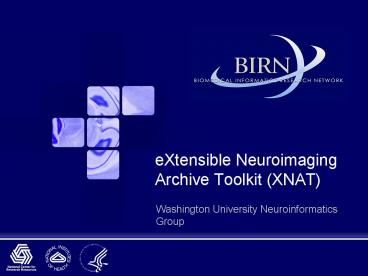eXtensible Neuroimaging Archive Toolkit (XNAT) - PowerPoint PPT Presentation
1 / 16
Title:
eXtensible Neuroimaging Archive Toolkit (XNAT)
Description:
An environment for developing experimental data archives (data store ... xs:enumeration value='Reptile'/ xs:enumeration value='Fish'/ /xs:restriction ... – PowerPoint PPT presentation
Number of Views:103
Avg rating:3.0/5.0
Title: eXtensible Neuroimaging Archive Toolkit (XNAT)
1
eXtensible Neuroimaging Archive Toolkit (XNAT)
- Washington University Neuroinformatics Group
2
What is XNAT?
- An environment for developing experimental data
archives (data store archiving tools). - Data store
- relational database for non-image data
- specified directory structure for image data.
- Archiving tools
- Web application for uploading, entering,
searching, visualizing, and otherwise exploring
data. - Command-line tools for batch handling data.
3
Why do we need XNAT (or something like it)?
Assessments
Metadata
Processed images
Derived data
Demographics
Raw images
4
Why do we need XNAT (or something like it)?
Assessments
Raw
Processed
Subject
MR Session
Derived
Demographics
Metadata
Secure User Interface
Integrated Data Store
5
What is XML Schema?
- XML Schema is a language for describing the
structure and contents of an XML document.
XML
XML Schema
ltClassgtBirdlt/Classgt
ltxselement nameClass"gt ltxssimpleTypegt
ltxsrestriction base"xsstring"gt
ltxsenumeration value"Bird"/gt
ltxsenumeration value"Mammal"/gt
ltxsenumeration value"Reptile"/gt
ltxsenumeration value"Fish"/gt
lt/xsrestrictiongt lt/xssimpleTypegt lt/xselementgt
6
XML Schema is the lingua franca for data exchange
- Data exchange requires standard open data
formats. - XML Schema is the language in which these open
formats are defined. - Many fields (e.g. genetics, medicine) have
already implemented XML Schema-based standards. - So an application that automatically archives,
searches, and displays XML Schema-based data
would be really useful
7
Welcome to XNAT
Data Documents
Database Schema
Java Classes
HTML Pages
CRATE TABLE table ( name, VARCHAR(50),
idMethod, VARCHAR(50), DEFAULT 'null,
type, VARCHAR(50), ID INT UNSIGNED, NOT NULL
AUTO_INCREMENT, PRIMARY KEY (ID) ) CREATE
TABLE table_column ( name VARCHAR(50)
javaName VARCHAR(50) primaryKey VARCHAR(50)
XML Schema
public class Experiment extends
org.cnl.cnda.om.BaseExperiment implements
Persistent public static final long
MILLIS_IN_DAY 86400000 public static long
getDays(Calendar c1, Calendar c2)
long time1 c1.getTime().getTime()
lt?xml version"1.0" encoding"UTF-8"?gt ltxsschema
xmlnsxnat"xnat.xsd" xmlnsxs"http//www.w3.org/
2001/XMLSchema" elementFormDefault"qualified"
attributeFormDefault"unqualified"gt ltxselement
name"Database"gt ltxsannotationgt ltxsappinfogt ltxna
tdbinfo database.name"CNDA" database"MYSQL"/gt lt
/xsappinfogt lt/xsannotationgt lt/xselementgt ltxsel
ement name"wm_mod_scheltens"gt ltxscomplexTypegt ltx
ssequencegt ltxselement ref"experiment"/gt ltxsele
ment name"session_id" type"xsstring"/gt ltxselem
ent name"assessment"gt
lt!DOCTYPE html PUBLIC "-//W3C//DTD HTML
3.2//EN"gt page.setTitle("CNDA -- Integrating
the Neurouniverse") page.setLinkColor(ui.alink)
page.setVlinkColor(ui.vlink) lthtmlgt ltbodygt ltta
ble border"0"gt lttrgt lttd bgcolor"336600"gt
lt?xml version"1.0" encoding"UTF-8"?gt ltsession
id"050202_vc1000"gt ltsubject map_num"0001"
lab_id"0001"gt ltagegt78lt/agegt
ltgendergtmalelt/gendergt lthandednessgtrightlt/h
andednessgt ltcohortgtADRClt/cohortgt
lt/subjectgt ltsession_infogt
ltacq_dategt5/1/2002lt/acq_dategt ltpigtRandy
Bucknerlt/pigt ltoperatorgtDan
8
This XML schema structure
9
becomes this database table
10
More complicated elements
11
yield more complicated tables
12
XNAT is a three-tiered architecture
Data Store
User Interface
13
The web application emphasizes usability and
quality control
- Clean user interface
- Search and download, no statistics.
- Quality control
14
Security is pretty important too
- Password protected login and session timeout.
- Secondary password and IP-address restriction on
most sensitive data. - User access privileges set by data type and meta
data values (e.g. Dan can view but not edit R
Buckners fMRI data.) - Signed approval on new user accounts and changes
to existing accounts. - Logins, queries, and downloads written to daily
log files.
15
XNAT is completely open source
- All of XNATs dependencies are open source.
- Turbine (Apache Jakarta) provides a servlet
based framework that allows developers to
quickly build web applications. - ImageJ (NIH) provides the foundation for the
image viewer. - MySQL and PostgreSQL databases are supported.
16
XNAT improvements are on the way
- Data quarantine
- Data history
- Direct XML?? Database exchange
- Improved image viewer with subcortical
segmentation and fMRI plugins. - Improved mechanisms for controlling display of
data. - Improved mechanisms for validating user input
from web forms.































